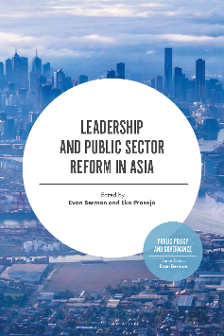Performance-based budgets
, 67
Performance-based reporting
, 8
Performance improvement framework (PIF)
, 9
Performance management frameworks
, 3
Permanent administrative organization
, 29–31
Philippines leadership in reform
in academia
, 167–170
Administrative Code of 1987
, 155
anti-red tape
, 159
Association of Southeast Asian Nations (ASEAN) region
, 154
‘bureaupathology,’
, 152
Civil Service Commission (CSC)
, 157
continuous monitoring and evaluation
, 154
decentralization
, 160
exemplary performance
, 157
globalization standards
, 154
HR accreditation
, 159
information, communication and technology (ICT)
, 159
ISO certification
, 159
Local Government Leadership Award’
, 160
local governments
, 159–161
marketing
, 159
New Public Management (NPM)
, 155
Philippine political administrative history
, 152
‘phronetic’ leaders
ASEAN region and Japan
, 161
bureaucracy and cynicism
, 166
Civil Registry Law
, 162
corruption
, 166
financial resources
, 166
Gawad Kalinga, non-government organization
, 164–165
group discussions and interviews
, 165
initiatives and innovations
, 166
national and local governments
, 162
Nonaka’s phronetic leadership paradigm
, 162
NSO’s human resources
, 163
practical wisdom concept
, 162
Quezon City (QC)
, 163–164
Presidential Commission on Government Reorganization (PCGR)
, 156
presidential-driven reforms
, 157
public administration system
, 153
reform implementation
, 160
reorganization initiatives
, 157, 158
resource generation and management
, 159
restructuring
, 159
revolutionary government
, 154
‘silo mentality,’
, 152
strategic performance management system
, 157, 159
streamlining processes and procedures
, 153
Policy making and policy execution
, 129
Political-economic policy
, 128
Political transformation programme (PTP)
, 211
Professional civil service
, 131
Provisional Commission for Administrative Reform
, 22
Public policy
, 1, 2, 27, 30, 91, 210–216, 232, 251
Public–private partnerships
, 3
Public Sector Development Commission (OPDC)
, 13
Public Sector Reform (PSR)
, 13
in Asia
accountability
, 3, 9–10, 16
advisory councils
, 7, 12
barriers
, 7
bureaucratic routine and rules
, 3, 8
champion leaders
, 12
citizens
, 2
definition
, 2
examples
, 2
five-year plans
, 12
implementation
, 7–9
initiating proposals
, 6–7
innovations
, 9–11
New Public Management
, 16
path dependency
, 10
Presidents/Prime Ministers
, 6, 12, 14, 16
in Australia.
, See also Australian leadership in reform
accountability
, 237, 238, 240, 246
bureaucracy
, 235, 236, 246
citizens and client orientation
, 246
implementation
, 236, 239, 245, 247, 249
initiatives
, 237
innovations
, 244
New Public Management
, 234, 237, 246
path dependency
, 245
Prime Ministers
, 246, 247
in China.
, See also Chinese leadership in reform
accountability
, 96–100
examples
, 96, 97
five-year plans
, 87, 101
implementation
, 97, 99
importance of
, 101
innovations
, 93, 94
Presidents
, 99, 101
in Indonesia.
, See also Indonesian leadership in reform
accountability
, 61, 67, 72
barriers
, 55
bureaucracy
, 57, 63, 76–77
champion leaders
, 78
citizens
, 59, 68
examples
, 62, 68
implementation
, 64–67
importance
, 78
initiatives
, 67–72
innovations
, 57
Presidents
, 54, 59, 65–66
in Japan.
, See also Japanese leadership in reform
advisory councils
, 24, 25, 31–32, 38
barriers
, 25
bureaucrat executives
, 33
examples
, 27, 31
implementation
, 22, 24, 27, 41–42
importance of
, 32–47
initiatives
, 30
Presidents/Prime Ministers
, 25, 33–48
successive administrative reform
, 24
in Malaysia.
, See also Malaysian leadership in reform
accountability
, 209, 210, 216, 219
bureaucracy
, 210–216
citizens
, 210, 219
examples
, 217, 218, 221
implementation
, 218, 226
initiatives
, 210, 217, 221, 223, 224, 228
innovations
, 210, 219, 224, 226, 227
New Public Management
, 224
Prime Ministers
, 210, 220–222
publicity
, 227
in New ZeaLand
accountability
, 262, 265, 280
bureaucratic advisors
, 266
citizens
, 275, 277–279
examples
, 276
implementation
, 263
importance of
, 259, 284
initiating
, 262
innovations
, 273–275
New Public Management
, 258
Prime Ministers
, 261–262
in Philippines
accountability
, 152–154, 156, 157, 166
bureaucracy
, 152, 156, 157, 166
citizens
, 153–154, 172
definition
, 152
examples
, 169
implementation
, 160, 167, 170, 172
initiatives
, 154–159, 163, 165, 166
innovations
, 152, 160, 161, 170
New Public Management
, 155
Presidents/
, 155–159, 167–170
in Singapore
accountability
, 183–185
barriers
, 192
bureaucratic procedures
, 186
client orientation
, 200, 201
examples
, 185, 186, 188, 190, 197
implementation
, 181
initiatives
, 185
Presidents/Prime Ministers
, 180, 199
in Thailand
, 103–126
accountability
, 107
bureaucracy
, 118, 119
champion
, 120
citizens
, 112, 119
examples
, 114
implementation
, 113
initiatives
, 117–119
innovations
, 113
New Public Management
, 112
Prime Ministers
, 106–108
in Vietnam
accountability
, 132, 133
barriers
, 139
bureaucracy
, 130, 139
citizens
, 129
examples
, 138, 145
implementation
, 141–143
importance of
, 137
initiatives
, 128, 138, 143
New Public Management
, 133, 134
Prime Ministers
, 137, 139, 140
